During the 7th edition of the INTERNATIONAL SCREENDANCE FESTIVAL MOVIMIENTO EN MOVIMIENTO, in 2018, 2 awards were given:
- National Screendance Award MOVIMIENTO EN MOVIMIENTO
- International Screendance Award MOVIMIENTO EN MOVIMIENTO
The first places were worth an economic stimulus of 1000 dollars for the continuation of their artistic career.
WINNERS:
- National Screendance Award MOVIMIENTO EN MOVIMIENTO:
First place: Doublevision (Benito González. Mexico.)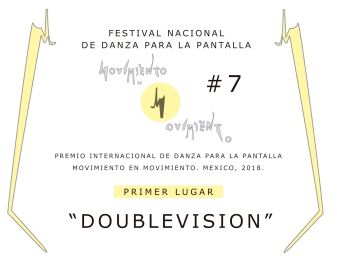
Second place: Sin Titulo, Sub Título (Antonio Arango. Mexico.)
Third place: Golem (Diego Chacón, Alexander Dluzalt, Ernesto Zavala y Carmen Ixchel Maya. Mexico.)
Honorary mention: El libro de la leche (Alfredo Salomón y Alejandra Alarcón. Mexico.)
Honorary mention: Exige otro t i e m p o (Dalia Ju. Mexico.)
Jury: Anna Macdonald, Andrea Keiz and a vote by Movimiento en Movimiento.
- International Screendance Award MOVIMIENTO EN MOVIMIENTO:
First place: This Dance Has No End (Fenia Kotsopoulou. Greece.)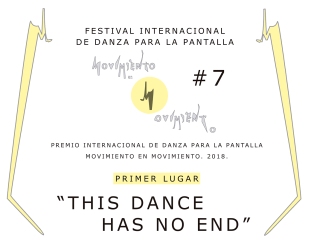
Second place: Leer (Thomas Bos. The Netherlands.)
Third place: Emotional Houdini (Allison Beda & Tara Cheyenne Friedenberg. Canada.)
Honorary mention: No more Beautiful Dances (Anabella Lenzu. Argentina.)
Honorary mention: A la Manera de David (Pedro Costa Prohens. Chile.)
Honorary mention: Medium Rare (Luca Cioci. Italy.)
Jury: Anna Macdonald, Alessandra Pisu, and a vote by Movimiento en Movimiento.
For this edition 200 films were received from 37 different countries during the call. 35 were selected: 25 international (Canada, Iceland, United States, United Kingdom, Argentina, Ireland, Italy, Chile, Brazil, Greece, France, Hungary, Israel, Russia, The Netherlands, Germany) and 10 Mexican films.
The three curators of Movimiento en Movimiento, Yolanda M. Guadarrama, Nayeli Benhumea and Lucitzel Pedrozo, united their votes in one to give weight to the votes of the international juries in the prizes.
BELOW YOU WILL FIND THE DESCRIPTION OF THE WINNING WORKS AND THE NOTES OF THE JURY. ALSO A SHORT BIO OF THE JURY.
****
DESCRIPTION OF THE WINNING WORKS AND THE NOTES OF THE JURY
- National Screendance Award MOVIMIENTO EN MOVIMIENTO:
First place: Doublevision (Benito González. Mexico.)

Synopsys: Doublevision is a cinematic atmosphere, a blend between a drowning lullaby with some industrial mantra.
Creator: Benito González was born and grew up in Hermosillo in the 70s and 80s. Motivated by pop art and mass culture, he founded, together with Evoé Sotelo, the scenic project Quiatora Monorriel in 1992, where he has had a constant presence for more than twenty-five years, during this time he has been able to show his work in Mexico and abroad. He has a wide choreographic repertoire and has collaborated with various stage groups. His creative inquiry has led him to also experiment in sound composition, photography, video and graphic design. His most recent works in video have been presented in several festivals nationally and internationally. He graduated in Choreography by the ENDCC and has been part of Sistema Nacional de Creadores at FONCA in 2010.
Jury note: We chose this screendance work because it is a piece of simple movement and high sensitivity that really marries the audiovisual medium and movement. Through the body in motion, a feeling that the time is flowing is transmitted. “Doublevision” shows the result of an intense experimentation with the moving image. First of all, renouncing the narrative sense and looking for meanings that are generated throughout the reworking of recorded images. These are visual manifests that are found by the exploration of new choreographic concepts, generated with editing elements and with the renunciation of the most common languages in the screendance genre.
Second place: Sin Titulo, Sub Título (Antonio Arango. Mexico.)

Synopsis: Sin Titulo, Sub Título (Untitled, Subtitled) was originally a video installation with 2 screens facing each other and holding a conversation. Reflecting as if they were self-aware. The dialogues are taken from various fiction films. The debate of both screens is about concepts of reality, fiction and the relationship of both as media frontiers.
Creator: Antonio Arango has a Bachelor level as Graphic Communication Designer. He has obtained several recognitions as the 3rd place in the Third Video Biennial in the category of Experimental and Video Art (“C ++”, 1994). He was worthy with the 2nd place in the Second Month of Performance (“C ++”, 1993) and obtained Honorary Mention in the 3rd Month of Performance in Ex-Teresa Alternative Art Museum (“Panopticon”, 1994). Winner of the interactive media facade for the Goethe Institute in Mexico (“Reflex”, 2005). He obtained honorable mention in the Festival of Electronic Art Transitio 2017 with the installation “Untitled, Sub titled”. His videos and interactive installations have been exhibited in Mexico (Museums and galleries) and in several festivals and exhibitions in the United States, Spain, Canada, Germany, Brazil, France, Japan and Chile. http://www.antonioarango.net
Jury note: By bringing these images of real and unreal bodies to the audiovisual movement, a question is brought to screendance: what bodies are allowed within this artistic genre, and what movements should be recorded? All the texts about reality and fiction, although they are too didactic, provoke the viewer to think about the necessity or the uselessness of the truth within the audiovisual dance film and screendance. It is a film that brings freshness, reflection and novelty to screendance. In addition, it is interesting how the found footage is edited into a narrative. Using the sound excerpts of some films in combination with these surreal photos, the result is a strange atmosphere. Considering the confronted images of this work as a dialogue, the reality of the actors looking at the puppets implies a surreal duplication of the spectator watching the installation.
Third place: Golem (Diego Chacón, Alexander Dluzalt, Ernesto Zavala y Carmen Ixchel Maya. Mexico.)
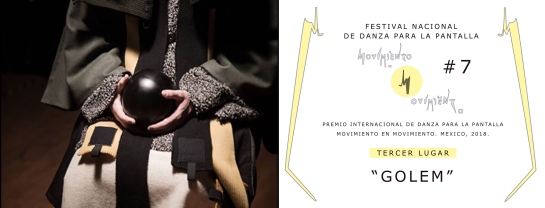
Synopsis: An infinite bond of creations. The constructor asks himself, through his creation, the meaning of existence. There is no such existence. Eventually, whoever that has been manufactured can as well become a producer of new imaginaries that he himself questions. The cycle is repeated.
Creator: Carmen Ixchel Maya (Mexico City, 1994) develops her work in the field of performance and moving image. She has been invited as perfomer at Teatro de la Danza, Museo Universitario del Chopo, GAMA (FAD), CMMAS in Morelia, Universidad Autonoma de Chapingo, Instituto de Investigaciones en Materiales en la Facultad de Ciencias (UNAM ), Salón de Danza UNAM, and Diego Rivera ́s Studio House. She was a resident artist of CaSa Oaxaca as part of the videodance and expanded scene laboratory RESONANCIAS. Her work in video has been presented in divers festivals in Colombia, Brazil, Madrid, Italy and Mexico.
Credits: Comunidad Sí: Ernesto Zavala, Alexander Dluzalt, Diego Chacón.
Collaborations: Prendas de H. by Hector de la Peña; Golem/Model – Alex Mediola (Paragon Models), Mujer (M) – Carmen Maya (COLECTIVO CM), Hombre (H) – Maximiliano Flores (ACADEMIA DE LA DANZA MEXICANA); Director of photography: Georgina Escalante; Editing: Carmen Ixchel Maya; Fixed photography: Lizet Trinindad; Assistance: Josué Mejía y Aquetzalli Chávez.
Jury note: Editing here is used as a choreographic tool. The strong rhythm in the cuts is supported and accompanied by electronic sound. The classic theme of the Golem, the manufacture of beings with non-organic materials, as well as the classical configuration in a triptychon are interrupted by the “scratching” of the video and the rhythm that occurs as a result, it is a classic theme treated throughout a non-classical editing filter, which implies a contrast in the experimental treatment of creation of this film.
Honorary mention: El libro de la leche (Alfredo Salomón y Alejandra Alarcón. Mexico.)

Synopsis: When he tasted the pomegranate his bones turned to blood. It is a video made with the work of Alejandra Alarcón, music by Atto Athié, animaciones by A. Solomon and the help of Sofi Otegui. Mexico, July 2018.
Creators: A. Salomón (México), transgenic artist with a deep technological orientation, graduated in Film, Television and Video from the University of the Americas-Puebla. His work is located in the periphery of audiovisual creation, choreographic language and the art industry. Member of the National System of Creators in Mexico, he is currently exploring the expressive possibilities of the body in front of the camera. He has represented Mexico in the main videodance festivals in America and Europe, his work has been exhibited in museums in Mexico, Colombia, Argentina, Chile, Canada, Holland, France, Austria and Taiwan.
Alejandra Alarcón was born in the city of Cochabamba, Bolivia 1976. She currently lives and works between Mexico and Bolivia. She got a degree in sociology at the Universidad Mayor de San Simón in Cochabamba Bolivia, also a degree in Plastic Arts at the National School of Painting and Sculpture “La Esmeralda” Mexico D.F. She has exhibited collectively and individually in museums, galleries and art fairs in various countries such as the United States, China, Italy, Peru, Brazil, Spain, Canada, Chile, Argentina, Portugal, England, Colombia, Bolivia and Mexico. Currently she’s part of the National System of Creators 2016 – 2019 in Painting.
Jury note: It’s a really sensual and thoughtful short piece. The parts of the body that are shown give us an idea of a sentimental and affective bond between mother and child. It conveys a sensory overload and a closeness to early motherhood. The images tell us about the foundation of life without the need to mention this foundation in words. It is a conceptual exercise that has a beautiful photography and circular-complex message and result.
Honorary mention: Exige otro t i e m p o (Dalia Ju. Mexico.)
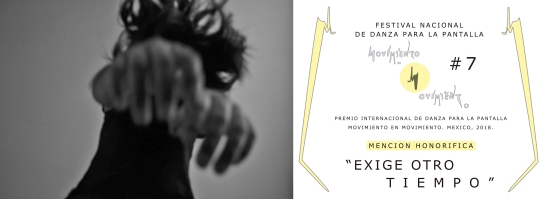
Synopsis: What is indeed internal listening? Exige otro t i e m p o (Demands another t i m e) is the result of two and a half years of investigation of movement derived from inner listening, where the body has been given opportunity to inhabit and speak. In this listening, motives of recurrent movement have been found, such as the agitation of the body, its undulation and its pauses. It is in that internal navigation where one finds oneself, one feels, one perceives the demand to live for instants, in another time.
Creator: Dalia Ramírez Pérez (Dalia Ju) was born on February 6th, 1994, in Mexico City. Her first encounter with the poetics of the movement was at the age of 8 years old in the community of Orizabita, Hidalgo when she took the Physical Theater workshop for children with the playwright Ramiro Ramírez. She was also part of the folk group of Huapango “Otomangue” (2003-2005). She attended her introduction and initiation in Contemporary Dance at the School of Artistic Initiation (EIA) No. 2 “Héctor Correa Zapata” 2006-2009. She later concluded her studies of Contemporary Dance Performer in the “Center for professional training for dancers in Contemporary Dance, Contemporanza”, space in movement, where she worked with various choreographers and directors (2012-2015).
Jury note: In this work dance seems to be the source of creation developed with the tradition of experimental films. Time is relative, abstract and personal. The body is dissolved into a moving surface and shown by fragments making a mysterious self-portrait that generates questions. We find a sensory search for movement throughout the loss of space.
Jury: Anna Macdonald, Andrea Keiz and a vote by Movimiento en Movimiento.
- International Screendance Award MOVIMIENTO EN MOVIMIENTO:
First place: This Dance Has No End (Fenia Kotsopoulou. Greece.)
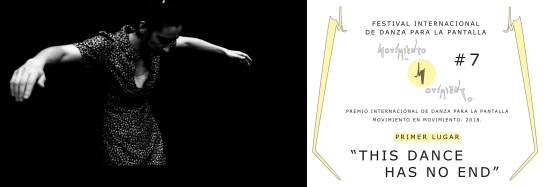
Synopsis: <“What happens when someone dies is that we, the living, contain their memory within us… They will live on in us, and we will celebrate them. And will dance like there is no tomorrow”. Diane Torr, a dancer dedicated to artist, drag king and gender activist, passed away in May, 2017. A year to the day, I danced in a black room: it was a single shot fusing male and female as an ode to life and death. The traditional urban dance zeybekiko, exclusively danced by men, was danced by my hybrid manifestation —blended aspects of my identity. In silence I heard Diane’s words “Take space with all your being. Own the space”. I lifted my arms and danced like there was no tomorrow while the camera followed. There were no edits or retakes: the aim was not to please or excite but to offer myself as a site for collective unburdening.> Fenia K.
Creator: Fenia Kotsopoulou (Greece) is a cross-disciplinary artist, based in UK, navigating creatively through the fields of performance (art), dance, video, and photography, in search of a fluid, hybrid and synthetic way of making art. She holds an MFA in Choreographing Live Art, and a BA Hons in Dance. Pivotal topics of her process-driven art practice include: Body as gathering place of emotions and site of transformation, personal and collective memory, (de)construction of fe-male identity, shame and acts of removal. In the past few years, as (dance) performer, producer and visual practitioner, her works and the work of close-collaborators have been shown and awarded at a wide array of festivals and art platforms, encompassing the fields of dance, experimental performance, live-art and video-art.
feniakotsopoulou.wix.com/artist
Note of the jury: The most outstanding of this piece is its strength, there is a deep feeling that is transmitted from the body in movement to the viewer of the audiovisual work, something that manages to be transmitted. It creates a perceptive atmosphere, and a great intensity with simple but very well directed audiovisual elements. It is interesting how the camera follows the body in its ceremonial dance. It is an exercise where the living remembers the dead, dancing with them and for them, transforming themselves into the memories, getting fused with them, and, in spite of being a feminine being, she becomes a masculine being. It is a beautiful and moving film.
Second place: Leer (Thomas Bos. The Netherlands.)

Synopsis: In the dancefilm Leer (Leather) we observe Hank. Hank has problems. Hank does not fit in. Riding his motorcycle enables him to clear his mind. Above a velocity of 130 everything becomes black and white. During his nightly drives his thoughts and reality become deeply entwined. Hank is no longer sure if his experience is real or not, but he is sure of one thing: if you twist the throttle far enough, no one will hear you cry in your helmet.
“I am interested in movement, humor and authenticity. Movement is nice because the body doesn’t lie. Agnes de Mille once said: “The truest expression of people is in their dance and in their music. Bodies never lie.” Video or film is the best way for me to really show something (movement for example); words are often used to hide stuff, images are used to show stuff. I like to tell something with humor. There is a misconception that equates solemnity with seriousness, and humor with the lack of seriousness. Something that is solemn could totally lack seriousness, and something humorous doesn’t necessarily lack seriousness. When someone is really laughing, you don’t need to know why. You can feel someone is laughing for real and this makes you laugh too.” Thomas Bos
Creator: Thomas Bos (1988) obtained his bachelor degree Digital Video Design in 2013 at the Hogeschool voor de Kunsten in Utrecht. He started (break)dancing with iLL Skill Squad at age 12. During his studies he did an internship for multimedia artist Oliver Laric in Berlin. Before, during and after his studies, Thomas has made autonomous videowork aswell as videowork for others including work for 155 (onefivefive), DOX, MAAS, de Krachtcentrale and Stukafest. Thomas is currently a dancer and artistic director at the dancecollective 155 (onefivefive) alongside his brother Erik.
Jury note: Leer is a piece that has richness in the way of approaching the camera shots, the edition and the experimental narrative through dance with very smooth movements that sometimes simulate electronic games movements. It has elements of cinema, video-art and screendance in a fortunate combination. It’s also a work with humor that invites the viewer to continue watching the film and enjoy it. Leer leads us to think of the classic motorcycle leather in another way.
Third place: Emotional Houdini (Allison Beda & Tara Cheyenne Friedenberg. Canada.)

Synopsis: Emotional Houdini is a comedic experimental dance film about aging, memory loss and the difficulties of communicating with your dad. DIRECTOR/PRODUCER/EDITOR/CINEMATOGRAPHER – Allison Beda. PERFORMER/CHOREOGRAPHER/PRODUCER – Tara Cheyenne Friedenberg. MUSIC/SCORE – Marc Stewart. SPANISH TRANSLATION – Jamina Wendland.
http://www.a-muse-productions.com http://www.allisonbeda.com http://www.taracheyenne.com http://www.marcstewartmusic.com
Creators: Writer/Director Allison Beda’s award winning films have been screened internationally at festivals, in theaters, on television, in art galleries, on billboards, in the metro and even at the Olympic games! Ms. Beda’s production company A Muse Productions loves making films about women who make trouble and film art that defies categorization. Allison studied film at Simon Fraser University, has an MFA in Film from University of British Columbia, honed her strong visual style working as an IATSE camera operator and learned when you can (and when you cannot) “fix it in post” working as an Associate Producer on shows like the SYFY/NBC series “12 Monkeys”.
Choreographer/Dancer Tara Cheyenne Friedenberg is a choreographer, performer, educator, and Artistic Director of Tara Cheyenne Performance. Based in Vancouver, she has been creating and performing her unique brand of hybrid dance-theatre for the past decade. And she is known for her expert blending of comedy, dynamic physicality, and character work. Tara has been nominated for several Jessie and Ovation awards for her theatrical choreography and is a 2014 recipient of the Chrystal Dance Prize.
Jury note: This is a film where the camera accompanies dance and humor in a dynamic way, it shows the eye that accompanies the feeling and movement of the performer in an experimental and artistic way, making a camera-content-dance dialogue. The dance arises from the body as an emotional symptom, giving a simple, fresh and accurate result.
Honorary mention: No more Beautiful Dances (Anabella Lenzu. Argentina.)
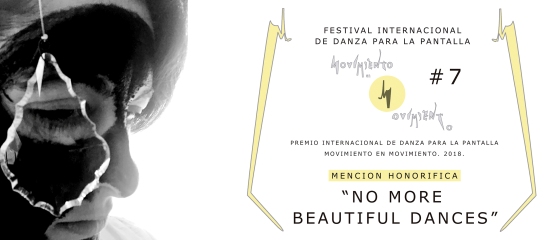
Synopsis: “No more beautiful dances” wrestles with the ideas of exploration, introspection and reframing a woman after becoming a mother, and being an immigrant. Lenzu’s dance theater piece uses spoken word and drawings to tell a personal vision of femininity, and what it means to be a woman today.
Creator: Originally from Argentina, Anabella Lenzu is a dancer, choreographer and teacher with over 25 years of experience working in Argentina, Chile, Italy and the USA. Classically trained at the renowned Teatro Colón in Buenos Aires, Lenzu studied the modern dance techniques of Humphrey/Limon and Graham in New York. Her choreography has been commissioned all over the world, for opera, TV programs, theatre productions, and by many dance companies, such as Anna Sokolow Theatre/Dance Ensemble. Lenzu has written for various dance and arts magazines, and published her first book in 2013, entitled Unveiling Motion and Emotion. The book contains writings in Spanish and English on the importance of dance, choreography, and dance pedagogy. http://www.Anabellalenzu.com
Jury note: This work questions the body as a stereotype from the perspective of dance film, and from the sight of a dancer who becomes “decadent” with the biological change of her body. The camera and editing accompany the general sense of the piece accentuating the important moments and giving different rhythms according to the expressed emotions. It is undoubtedly a work of human and feminine introspection.
Honorary mention: A la Manera de David (Pedro Costa Prohens. Chile.)

Synopsis: David is a young street sweeper who is obsessed with Iggy Pop and one day he finds a short documentary about Michelangelo’s David and after that he wants to become the famous sculpture and that’s where he starts loosing control on his own existence and reality.
Creator: I studied Film at the Film School of Chile, and in 2017 I studied a Master in Cinematographic Direction in Barcelona, where I made the short film A la Manera de David (In the manner of David).
Jury note: This work is explicitly experimental. It has to do with the body and body movement, although not from the dance, but from a human and aesthetic perspective. The character goes from having an ordinary obsession for a pop singer to seek an obsession for a mythical figure in classical culture. And it shows how fragile and insecure minds, without basic foundations can be influenced… It has humor and is very well cinematographically solved. Refreshes the idea of the limits that dance film and screendance can embrace.
Honorary mention: Medium Rare (Luca Cioci. Italy.)
Synopsis: Medium Rare is an animation film. It analyses human interaction with objects and their functional and aesthetic presence in recurrent, yet questionable domestic scenarios.
Creator: Luca Cioci is a filmmaker and visual artist from Italy. He recently graduated with a BFA in Animation from CalArts and currently resides in Los Angeles working as a multi-disciplinary freelancer.
Jury note: Medium Rare is an affective, stark, compelling film. Its timing has been patiently constructed. It has surreal moments like a fish bowl bobbing in the wood as if it were water. This animation film treats about the body in its daily act of inhabiting the world, although the body is absent, it is only guessed because all the objects move as if a body manipulated them. The absence of the body tells us necessarily something about the body. And a human crisis is guessed through the influence on the objects that the body normally uses. Medium Rare refreshes the idea of the limits that dance film and screendance can embrace.
Jury: Anna Macdonald, Alessandra Pisu, and a vote by Movimiento en Movimiento.
BRIEF DESCRIPTION OF THE JURY:
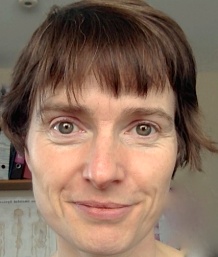 Anna Macdonald
Anna Macdonald
Anna Macdonald (annamacdonaldart.co.uk) is a moving image dance artist and scholar from the UK. She specialises in working directly with the public, finding ways to intensify and articulate people’s experiences in ways that can be understood by others. Anna’s work has been shown at galleries and festivals such as Athens Video dance project, Festival Ciné-Corps, Paris, Art Currents, New York, Somerset House, London, Dascamdans, Belgium, Miden Festival, Greece, VideodanzaBA, Argentina. She was nominated for the International Video Dance awards in Barcelona and her work was selected as a flagship project for AHRC funded research into socially engaged art.
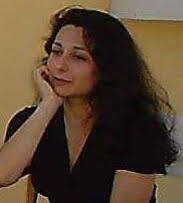 Alessandra Pisu
Alessandra Pisu
Alessandra Pisu. Studies literature at University in Cagliari.
Since the early 2000s works in the organization of Festival Internazionale Nuova Danza, and of its collateral events.
In the same years she started collaborating with the contemporary dance company ASMED, as event organizer and promoter.
Alessandra is a Member and co-founder of MayaInc, currently running Festival Internazionale Nuova Danza (FIND).
From 2005 to 2008 She has worked with MayaInc at I-Contest, a short film and video art festival, and also during the first editions of Maya Film Festival (2010-11).
She works as an organizer and performer in acting intensive courses organized by MayaInc in Cagliari.
From 2016 Alessandra has been the curator of Breaking 8, international videodance festival, which emmerged as collateral project of FIND festival in 2013.
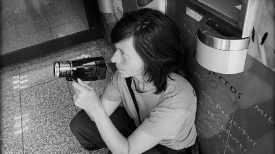 Andrea Keiz
Andrea Keiz
Andrea Keiz is an educated biologist and teacher for dance improvisation.
Since 2000 she’s been working as a freelance artist in the field of video documentation of performing arts. Besides filming and editing, she is advising students in documentation, camera work and archiving in several dance programs in Germany as well as offering workshops in video//dance and perception. www.andrekeiz.de
MOVIMIENTO EN MOVIMIENTO TEAM
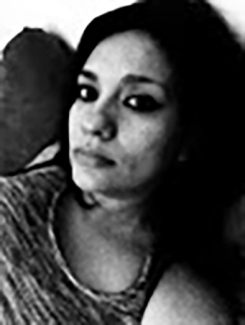 Lucitzel Pedrozo
Lucitzel Pedrozo
Master of Visual Arts at the UNAM. Video maker, producer, researcher, iconographer and editor. As a maker she developed more than 50 productions among TV series, capsules and documentaries Unam (2007-2013). As a film maker, in recent years, she has investigated the possibilities of Butoh dance in videodance and its application in different disciplines such as animation and video installation. She has also developed editorial projects such as the Abul Abbas publication and as a columnist for the art section of the Más Claro magazine. As a researcher, she was invited to the VideodanzaBA Festival in Buenos Aires to a workshop of Douglas Rosenberg in 2013; In 2015, she carried out a research residency on video installation at the UPV; and in 2017 he was a lecturer at the VII University Colloquium on Cinematographic Analysis “Cinema in the Expanded Field” held at MUAC.
www.lucitzel.com
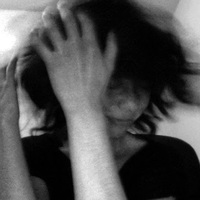 Nayeli Benhumea
Nayeli Benhumea
“I research and write about videodance, feminism and body, drawing and dancing. I am interested in the search of myself through the camera-body bond and its various ways of relating; It is through this exploration that I try to observe myself, discover myself, recognize myself and find myself in my own experience. Currently I take this exploration to various manifestations such as writing, drawing and performance as fields of political action, to question the notions of the feminine, love, desire, eroticism and violence in women’s bodies. I studied the Master of Visual Arts at UNAM, I am currently writing my thesis on the idea of inhabiting videodance; I hold a dgree in Graphic Communication Design from UAM-A; I did the Specialty in Dancing Creation at the CICO, INBA. I wrote together with Hayde Lachino the book Videodance: From the scene to the screen. My work has been shown at international festivals. I am a professor of Video Art and Researcher of Artistic Projects in the Faculty of Arts, UAEMEX; I work as an independent editorial designer, I collaborate with the Department of Evaluation in Time, CyAD, UAM-A, and with independent artists.”
https://nayelibenhumea.wordpress.com/
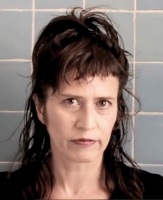 Yolanda M. Guadarrama
Yolanda M. Guadarrama
Yolanda M. Guadarrama is the director of Movimiento en Movimiento, she already has several years of experience in the field of screendance. She made her first screendance work in 1994. He has been a Screendance for LIFF festival in England. Now she is completely dedicated to the creation and diffusion of this artistic genre, writing texts, teaching courses, making her own creations and promoting the festival that she directs. She has been curating RIFF festival (R.E.D. International Film Festival) in Norway for 4 years. She has also been editor and founder of Revista y Editorial MOHO, together with Guillermo Fadanelli. Among her screendance creations she has got 11 pieces, several of them have been shown at international festivals. His two awarded pieces are: Ailing Animal, Honorary Mention in Agite and Sirva, Mexico 2015; Potato Eaters, Best experimental film, Eurasia International Festival, Moscow, June 2018. https://www.yolandamguadarrama.com/
